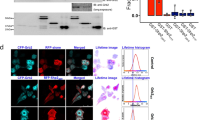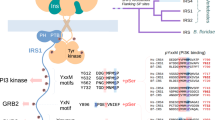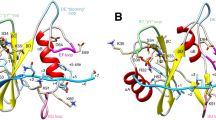Abstract
Breast tumor kinase (Brk) is a nonreceptor tyrosine kinase that is overexpressed in a high percentage of breast carcinomas. Brk contains SH3, SH2, and tyrosine kinase catalytic domains in a similar arrangement as Src family kinases. In this study, we explored the roles of the SH3 and SH2 domains in Brk regulation and substrate binding. We introduced a series of mutations into Brk that were predicted to disrupt the intramolecular interactions involving the SH3 and SH2 domains. These mutant forms of Brk displayed higher activity than wild-type Brk when expressed in human embryonic kidney HEK293 cells. These studies also allowed us to pinpoint the intramolecular binding site for the SH3 domain. To examine substrate binding, we compared binding and phosphorylation of Sam68, a physiological substrate of Brk. These experiments showed that the SH3 domain plays a particularly important role in substrate recognition. We confirmed this conclusion using a series of synthetic peptides in which a substrate sequence was coupled to an SH3 or SH2 ligand. The SH3-binding substrate had a significantly lower Km than a control, while no difference was observed between an SH2-binding substrate and a control. Taken together, our data suggest that SH3 interactions will govern phosphorylation of many substrates by Brk.
This is a preview of subscription content, access via your institution
Access options
Subscribe to this journal
Receive 50 print issues and online access
$259.00 per year
only $5.18 per issue
Buy this article
- Purchase on Springer Link
- Instant access to full article PDF
Prices may be subject to local taxes which are calculated during checkout







Similar content being viewed by others
References
Alexandropoulos K and Baltimore D . (1996). Genes Dev., 10, 1341–1355.
Barker KT, Jackson LE and Crompton MR . (1997). Oncogene, 15, 799–805.
Barker SC, Kassel DB, Weigl D, Huang X, Luther MA and Knight WB . (1995). Biochemistry, 34, 14843–14851.
Briggs SD, Sharkey M, Stevenson M and Smithgall TE . (1997). J. Biol. Chem., 272, 17899–17902.
Brown MT and Cooper JA . (1996). Biochim. Biophys. Acta, 1287, 121–149.
Coyle JH, Guzik BW, Bor YC, Jin L, Eisner-Smerage L, Taylor SJ, Rekosh D and Hammarskjold ML . (2003). Mol. Cell. Biol., 23, 92–103.
Derry JJ, Prins GS, Ray V and Tyner AL . (2003). Oncogene, 22, 4212–4220.
Derry JJ, Richard S, Valderrama Carvajal H, Ye X, Vasioukhin V, Cochrane AW, Chen T and Tyner AL . (2000). Mol. Cell. Biol., 20, 6114–6126.
Easty DJ, Mitchell PJ, Patel K, Florenes VA, Spritz RA and Bennett DC . (1997). Int. J. Cancer, 71, 1061–1065.
Erpel T, Superti-Furga G and Courtneidge SA . (1995). EMBO J., 14, 963–975.
Fumagalli S, Totty NF, Hsuan JJ and Courtneidge SA . (1994). Nature, 368, 871–874.
Hantschel O, Nagar B, Guettler S, Kretzschmar J, Dorey K, Kuriyan J and Superti-Furga G . (2003). Cell, 112, 845–857.
Harvey AJ and Crompton MR . (2003). Oncogene, 22, 5006–5010.
Jove R and Hanafusa H . (1987). Annu. Rev. Cell Biol., 3, 31–56.
Kamalati T, Jolin HE, Fry MJ and Crompton MR . (2000). Oncogene, 19, 5471–5476.
Kamalati T, Jolin HE, Mitchell PJ, Barker KT, Jackson LE, Dean CJ, Page MJ, Gusterson BA and Crompton MR . (1996). J. Biol. Chem., 271, 30956–30963.
LaFevre-Bernt M, Sicheri F, Pico A, Porter M, Kuriyan J and Miller WT . (1998). J. Biol. Chem., 273, 32129–32134.
Liu X, Brodeur SR, Gish G, Songyang Z, Cantley LC, Laudano AP and Pawson T . (1993). Oncogene, 8, 1119–1126.
Llor X, Serfas MS, Bie W, Vasioukhin V, Polonskaia M, Derry J, Abbott CM and Tyner AL . (1999). Clin. Cancer Res., 5, 1767–1777.
Mayer BJ and Baltimore D . (1994). Mol. Cell. Biol., 14, 2883–2894.
Mayer BJ, Hirai H and Sakai R . (1995). Curr. Biol., 5, 296–305.
McPherson RA, Taylor MM, Hershey ED and Sturgill TW . (2000). Oncogene, 19, 3616–3622.
Miller WT . (2003). Acc. Chem. Res., 36, 393–400.
Mitchell PJ, Barker KT, Martindale JE, Kamalati T, Lowe PN, Page MJ, Gusterson BA and Crompton MR . (1994). Oncogene, 9, 2383–2390.
Mitchell PJ, Sara EA and Crompton MR . (2000). Oncogene, 19, 4273–4282.
Moarefi I, LaFevre-Bernt M, Sicheri F, Huse M, Lee CH, Kuriyan J and Miller WT . (1997). Nature, 385, 650–653.
Nagar B, Hantschel O, Young MA, Scheffzek K, Veach D, Bornmann W, Clarkson B, Superti-Furga G and Kuriyan J . (2003). Cell, 112, 859–871.
Nguyen JT and Lim WA . (1997). Nat. Struct. Biol., 4, 256–260.
Pawson T, Gish GD and Nash P . (2001). Trends Cell Biol., 11, 504–511.
Pellicena P, Stowell KR and Miller WT . (1998). J. Biol. Chem., 273, 15325–15328.
Qiu H and Miller WT . (2002). J. Biol. Chem., 277, 34634–34641.
Scott MP and Miller WT . (2000). Biochemistry, 39, 14531–14537.
Serfas MS and Tyner AL . (2003). Oncol. Res., 13, 409–419.
Sicheri F and Kuriyan J . (1997). Curr. Opin. Struct. Biol., 7, 777–785.
Sicheri F, Moarefi I and Kuriyan J . (1997). Nature, 385, 602–609.
Songyang Z, Carraway KL, III Eck MJ, Harrison SC, Feldman RA, Mohammadi M, Schlessinger J, Hubbard SR, Smith DP, Eng C, Lorenzo MJ, Poner BAJ, Mayer BJ and Cantley LC . (1995). Nature, 373, 536–539.
Taylor SJ and Shalloway D . (1994). Nature, 368, 867–871.
Tian M and Martin GS . (1997). Mol. Biol. Cell, 8, 1183–1193.
Vasioukhin V, Serfas MS, Siyanova EY, Polonskaia M, Costigan VJ, Liu B, Thomason A and Tyner AL . (1995). Oncogene, 10, 349–357.
Wang D, Huang XY and Cole PA . (2001). Biochemistry, 40, 2004–2010.
Xu W, Harrison SC and Eck MJ . (1997). Nature, 385, 595–602.
Young MA, Gonfloni S, Superti-Furga G, Roux B and Kuriyan J . (2001). Cell, 105, 115–126.
Acknowledgements
This work was supported by a grant from the NIH to WTM (CA28146).
Author information
Authors and Affiliations
Corresponding author
Rights and permissions
About this article
Cite this article
Qiu, H., Miller, W. Role of the Brk SH3 domain in substrate recognition. Oncogene 23, 2216–2223 (2004). https://doi.org/10.1038/sj.onc.1207339
Received:
Revised:
Accepted:
Published:
Issue Date:
DOI: https://doi.org/10.1038/sj.onc.1207339
Keywords
This article is cited by
-
Designer installation of a substrate recruitment domain to tailor enzyme specificity
Nature Chemical Biology (2023)
-
Understanding the cellular roles of Fyn-related kinase (FRK): implications in cancer biology
Cancer and Metastasis Reviews (2016)
-
Constitutive activation of breast tumor kinase accelerates cell migration and tumor growth in vivo
Oncogenesis (2012)
-
Brk/PTK6 sustains activated EGFR signaling through inhibiting EGFR degradation and transactivating EGFR
Oncogene (2012)
-
Mechanisms of HGF/Met Signaling to Brk and Sam68 in Breast Cancer Progression
Hormones and Cancer (2012)



